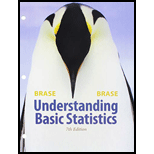
Concept explainers
Critical Thinking Suppose two
(a) What formula is used to compute P(A and B) ? Is
(b) Using the information from part (a), can you conclude that events A and B are not mutually exclusive?
Want to see the full answer?
Check out a sample textbook solution
Chapter 5 Solutions
Bundle: Understanding Basic Statistics, Loose-leaf Version, 7th + WebAssign Printed Access Card for Brase/Brase's Understanding Basic Statistics, ... for Peck's Statistics: Learning from Data
- Answer the following questions. 3. When given two separate events, how do we know whether to apply the Addition Principle or the Multiplication Principle when calculating possible outcomes? What conjunctions may help to determine which operations to use?arrow_forwardDividing a JackpotA game between two players consists of tossing a coin. Player A gets a point if the coin shows heads, and player B gets a point if it shows tails. The first player to get six points wins an 8,000 jackpot. As it happens, the police raid the place when player A has five points and B has three points. After everyone has calmed down, how should the jackpot be divided between the two players? In other words, what is the probability of A winning and that of B winning if the game were to continue? The French Mathematician Pascal and Fermat corresponded about this problem, and both came to the same correct calculations though by very different reasonings. Their friend Roberval disagreed with both of them. He argued that player A has probability 34 of winning, because the game can end in the four ways H, TH, TTH, TTT and in three of these, A wins. Robervals reasoning was wrong. a Continue the game from the point at which it was interrupted, using either a coin or a modeling program. Perform the experiment 80 or more times, and estimate the probability that player A wins. bCalculate the probability that player A wins. Compare with your estimate from part a.arrow_forwardDividing a Jackpot A game between two pIayers consists of tossing coin. Player A gets a point if the coin shows heads, and player B gets a point if it shows tails. The first player to get six points wins an $8000 jackpot. As it happens, the police raid the place when player A has five points and B has three points. After everyone has calmed down, how should the jackpot be divided between the two players? In other words, what is the probability of A winning (and that of B winning) if the game were to continue? The French mathematicians Pascal and Fermat corresponded about this problem, and both came to the same correct conclusion (though by very different reasoning's). Their friend Roberval disagreed with both of them. He argued that player A has probability of Winning, because the game can end in the four ways H, TH, TTH, TTT, and in three of these, A wins. Roberval’s reasoning was wrong. Continue the game from the point at which it was interrupted, using either a coin or a modeling program. Perform this experiment 80 or more times, and estimate the probability that player A wins. Calculate the probability that player A wins. Compare with your estimate from part (a).arrow_forward
 Holt Mcdougal Larson Pre-algebra: Student Edition...AlgebraISBN:9780547587776Author:HOLT MCDOUGALPublisher:HOLT MCDOUGAL
Holt Mcdougal Larson Pre-algebra: Student Edition...AlgebraISBN:9780547587776Author:HOLT MCDOUGALPublisher:HOLT MCDOUGAL
 Algebra and Trigonometry (MindTap Course List)AlgebraISBN:9781305071742Author:James Stewart, Lothar Redlin, Saleem WatsonPublisher:Cengage Learning
Algebra and Trigonometry (MindTap Course List)AlgebraISBN:9781305071742Author:James Stewart, Lothar Redlin, Saleem WatsonPublisher:Cengage Learning College AlgebraAlgebraISBN:9781305115545Author:James Stewart, Lothar Redlin, Saleem WatsonPublisher:Cengage Learning
College AlgebraAlgebraISBN:9781305115545Author:James Stewart, Lothar Redlin, Saleem WatsonPublisher:Cengage Learning Algebra & Trigonometry with Analytic GeometryAlgebraISBN:9781133382119Author:SwokowskiPublisher:Cengage
Algebra & Trigonometry with Analytic GeometryAlgebraISBN:9781133382119Author:SwokowskiPublisher:Cengage





